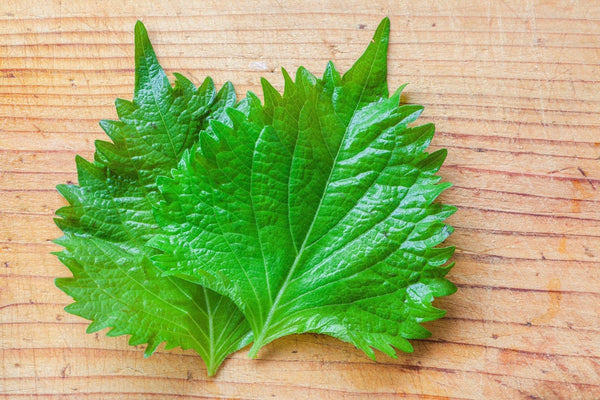
Jump to:
The first place you encounter “shiso” in Japan may be as a leaf bed for sushi. In fact, the popularity of sushi may be largely responsible for the word “shiso” being used as part of the English lexicon today. While it is true that the vibrant green leaves and bright yellow flowers provide a beautiful decorative garnish to dishes, shiso is also widely used in cuisine and has some great nutritional benefits.
The plant referred to by the Japanese name “Shiso” is a member of the mint family Lamiaceae, and, for this reason, is sometimes referred to as “Japanese mint”, but given its taste profile, which is more of a combination between mint, anise, and basil, pigeon-holing it as mint does not really do it justice.
In this article, we will look at what shiso is, how it differs from similar types of plants, and how to use shiso in various types of food, beverages, and oils. Before looking at its nutritional benefits, we will also look at tips for storing shiso and even growing it yourself.
Family Ties To Shiso
Because of its connection to sushi and sashimi, shiso is seen as something essentially Japanese, but in fact, it is not even native to Japan and hails from the mountainous regions of China and India
The Lamiaceae family of plants, to which shiso belongs, is a group of flowering plants that includes aromatic culinary herbs such as basil, mint, rosemary, sage, and indeed shiso, as well as medicinal herbs, such as catnip and oriental motherwort.
Within this category, there is not just one type of shiso either, and different types are used in Japan in different situations. The main types you will encounter will be the purpled-leaved or red shiso (akajiso) and green shiso (aojiso), but there is also bicolor shiso, where the leaves are green on the top and red on the bottom, and variegated shiso, in which the leaves are a mixture of green on both sides.
It is mainly the first two that you will be eating, however, and they are used differently according to their taste profile. For example, red shiso tends to be more bitter than the green variety and so is more suited for cooked dishes and pickling than for salads and garnishes. This will be described in more detail later in the article.
Shiso vs Perilla

Shiso is a variety of perilla frutescens, but in this blog post, to avoid confusion, perilla will refer to a cousin of Japanese shiso that is popular in the cuisine of Korea (where it is known as Kkaennip) as well as other countries in Asia.
Perilla has broader leaves with less of a serrated edge. It has a strong herbaceous taste closer to licorice, and it tends to be used as a wrap for other food, rather than as a direct ingredient or garnish as is the case with its more cousin, shiso, which, as discussed, has more of a basil-like taste.
Popular Shiso Food
Shibazuke Pickles

As described above, red shiso has a somewhat bitter flavor. In Kyoto, it is combined with ginger, eggplant, cucumber, and myoga (Japanese-style ginger), to make shibazuke pickles.
Here, the red shiso also serves as an excellent colorant and gives it a beautifully natural purple color. It is also used to add to the redness of umeboshi plum pickles and myoga ginger, without using artificial colorants.
You can use umezu, or ume red shiso vinegar, when making Shibazuke pickles at home, to give them that vibrant purple color.
Furikake

The leaves of the red plant can be pulverized and dried to make yukari. This is a rice seasoning, considered a type of furikake, made of red shiso leaves and salt. Furikake is a mainstay of Japanese home cooking and bento boxes, providing a very economical way of adding extra minerals and nutrients to rice dishes, while simultaneously stimulating the appetite with its delicious taste.
Curious to try some “Yukari” furikake on your rice? Make the Japanese Taste website your first port of call.
Foods with Green Shiso

There is also a plethora of uses for green shiso as well. Its use with sushi has already been mentioned, but it can also be used as a garnish for chilled noodles, sashimi (raw fish), or hiya-yakko (a type of chilled tofu). Green shiso is also a popular ingredient in vegetable tempura, where whole green leaves are customarily battered on one side only and deep-fried for just one minute.
Its chopped leaves may be used in a variety of different sauces, such as pesto sauce and umeboshi plum size, as well as a topping for pasta and pizza, and used to flavor fried rice. Using shiso where you might normally use mint can add a novel twist to your desserts.
It is not only the leaves that can be eaten, and there are plenty of culinary opportunities to utilize other parts of the plant. These include shiso seed pods, which can be combined with daikon (giant radish) to make a delicious crunchy salad. Shiso flowers (hojiso) can often be found placed on top of daikon (again) when serving sashimi. Not only do these vibrant yellow flowers add color to the dish, but the petals can also be squeezed off and added to the soy sauce dip for extra flavor.
Shiso-Charged Beverages

Shiso colors Japanese drinks as well as food and umeboshi plum wine is often soaked in red shiso leaves to give the wine a bright red hue that adds to its appeal. It is also used to make a deliciously refreshing beverage called aka shiso juice that is enjoyed in the summer. This is typically made by making a base syrup out of red shiso leaves, sugar, and apple cider vinegar. The sugar in the syrup means that it will keep in a jar in your refrigerator for up to one year. Once the base syrup is made, just add ice and water to serve. If you have a hankering for a different kind of drink, you can add a shot of your favorite alcohol to make a delicious cocktail.
Red shiso can also be used to make a delicious, aromatic, and vibrantly colored tea, to which you can give a natural tartness by adding lemon or lime. Shiso has long been used as a natural remedy and, in addition to being free of caffeine, which will enable you to drink it any time of the day, it provides a powerful antioxidant infusion that your body will thank you for. The myriad of health benefits of shiso is explained a little later in this post.
Egoma Oil

The uses of shiso don’t end there either. The oil from egoma, which is at least a close relative of shiso, is gaining attention as a healthy addition to your salad. Oil is pressed from the egoma seeds, slowly without heat processing, which can eliminate its nutritional advantages, after carefully separating them from the leaves and stalks. But what is so special about this type of oil?
Egoma seeds contain a high ratio of α-linoleic acid, an essential omega-3 polyunsaturated fatty acid. When we consume APA, it is converted into EPA and DHA in our bodies, which is known to help protect cognitive function, prevent metabolic syndrome, and suppress chronic inflammation. As EPA and DHA are commonly found in fish oil, egoma oil provides an excellent alternative way for vegans to obtain this vital nutrient.
You can pick up some healthy egoma oil from the Japanese Taste website here.
G.I.Y (Grow it Yourself)?

Whereas, of course, you can purchase shiso in all of the normal places where you would buy vegetables, such as supermarkets and greengrocers, you might also be tempted to try growing it yourself.
You can plant shiso seeds anywhere outside as they can grow in most types of soil. Some gardeners argue that soaking the seeds in water for 24 hours improves germination.
While not that fussy about the soil, shiso plants do need their sunlight and are vulnerable to cold weather. Because of this vulnerability, some growers will leave them in temperature-controlled or at least generally warmer environments like greenhouses. Shiso leaves can normally be harvested around eight weeks after sowing.
Tips For Storing Shiso
Shiso leaves do not stay fresh at room temperature very long because they dry out very easily, but you can extend the life of your fresh shiso (to about four days) by placing them in the refrigerator, preferably inside a damp cloth to keep them moist.
Another way of getting longer use out of your shiso is to wash and dry the shiso leaves, place them in a container, and sprinkle with salt, repeating this process for all of your shiso leaves.
Finally, for long-term storage, you can wrap the shiso leaves in a paper towel, place them in a freezer bag and keep them frozen in the freezer right up to the point when you need to use them.
Nutritional Benefits Of Shiso
Because of the way it is commonly seen as being nothing more than a garnish, you might be tempted to think that shiso only plays a decorative role on your plate. However, the truth is that shiso is incredibly rich in nutrients. Firstly, it has a mainstay provider of calcium and iron. Calcium is essential for building and maintaining strong bones and teeth, and iron, an essential mineral for blood function and making certain hormones. Shiso is a good source of omega-3 fatty acids, the benefits of which have already been described in relation to egoma oil. It is also extremely high in carotene, with approximately ten times the quantity found in pumpkin gram for gram.
Shiso has been used as a home remedy for treating respiratory and gastrointestinal ailments and is a rich source of antioxidants. The bottom line is that if you care about your body, make sure you consume that shiso leaf, rather than pushing it to the side of the plate.
Shiso – The Versatile And Healthy Herb

While denigrated by some as being little more than a garnish for sushi, shiso is a delicious and versatile herb, the nutritional properties of which virtually classify it as a superfood. Both the red and green varieties are used in a wide range of food and drink, not only for their exquisite subtle flavors but also their aesthetic properties, providing vibrant colors that delight the mind and stimulate the appetite. Lastly, as the seeds and flowers can also be consumed, in addition to the leaves, this is in unison with the Japanese ethic of avoiding waste.
What is your favorite way of enjoying shiso? Let us know in the comments.


0 comments